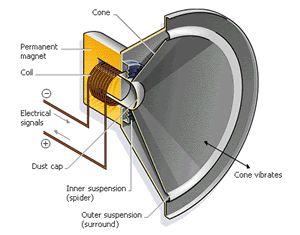|
The discovery of electromagnetism led to
a large number of inventions and devices. Being able to
turn magnetism on and off, the great strength of
electromagnets, and being able to vary the magnetism by
varying the electrical current are characteristics of
electromagnetism used in many inventions. Some devices
reverse the characteristics to create another class of
devices.
Questions you may have include:
-
How is the strength of an
electromagnet used?
-
How is moving something though
varying magnetic strength used?
-
How can some inventions be reversed?
Lifting and dropping objects
The magnetic strength of an
electromagnet depends on the number of turns or wire and
the current through the wire, and the size of the iron
core. This allows electromagnets to be made much larger
and stronger than a natural magnet, such that they can
pick up very large objects.
Also, when you turn off the electricity
to an electromagnet, the magnetism is also turned off.
Thus, an electromagnet can be used to pick up a piece of
iron and then drop it someplace else.
Crane uses electromagnet to pick up
junked car
Strong electromagnets are often used in
areas of heavy industry to move large pieces of iron or
steel. They are commonly employed in junkyards, where a
crane with a huge electromagnet is used to pick up, move
and drop old, junked cars.
Creating motion
Changing the electrical current through
an electromagnet changes its strength and even direction
of its magnetic field. This effect can be used to create
controlled motion of objects, which in turn can result
in some interesting results.
The loudspeakers in your radio, TV or
stereo system use varying electric current through an
electromagnet to create sound. The electric current
varies at a fast rate, causing the strength of the
magnetic field to vary. This results in moving the
loudspeaker membrane or cone back and forth rapidly,
resulting in sound and even music.

Cut-out of a loudspeaker
Take a look at a loudspeaker and see the
coil of wire and electromagnet in its back area. Some
loudspeakers use a solenoid instead of an electromagnet.
An electric motor is an even more clever
application of electromagnets. Suppose you put some
electromagnets on a wheel and put some permanent magnets
around the wheel. The electromagnets could be made to
attract and repel the surrounding magnets, causing the
wheel to turn.
Look at an electric motor and see the
internal wheel made of electromagnets and the outer
shell made of permanent magnetic material.
Creating electricity
You can reverse many of these
inventions. You have seen that changing an electric
current can change the magnetic field and cause varying
motion of an object. By reversing that, you can move a
magnet to create an electrical current.
This is a result of an amazing duality
principle that you will see many times in science, in
that you can reverse ideas or inventions.
Suppose you took a loudspeaker or an
earphone and vibrated its membrane with sound? The
movement of the coiled wires or solenoid in the magnetic
field would work just the opposite of a loudspeaker, and
a varying electrical current would be created. You would
now have a microphone.
Now if electric current moving though a
wire creates a magnetic field, could just the opposite�a
wire moving through a magnetic field�cause electric
current? The answer is yes.
If you take a N and S magnet and pass a
wire through their magnetic field, electric current will
flow through the wire.

Moving a magnet through coils of wire
creates electricity
If you took an DC electric motor and
spun the rotor, its wires would cut through the magnetic
fields and create electricity. An electric generator is
simply an electric motor that you are spinning.
The grooves in a phonograph record cause
the needle to vibrate. Electronic amplifies the signal
and rapidly turns the current to the loud speaker on and
off. This results in playing of the sound that was
previous recorded into those grooves.
Electromagnetic devices and inventions
include a large magnet to lift up and drop automobiles,
the loudspeaker, electric motor, microphone, electric
generator, and phonograph. Some devices use the opposite
effects as others. The loudspeaker and microphone are
examples of this. |